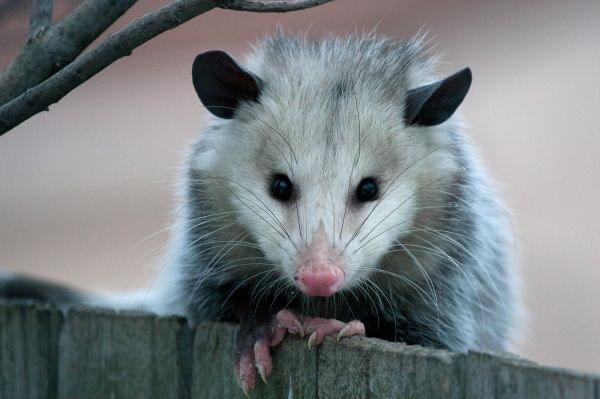A sympathetic look at a misunderstood marsupial

A Virginia opossum in the backyard of the author's in-laws in Cleveland, Ohio. Rob Kanter
I found this article by a student from my environmental writing class very engaging, and think Environmental Almanac listeners will too.
--RK
My mother hates opossums. She hates their hairless tails, she hates their pointy teeth, and she hates their black, “soulless” eyes. She hates how they waddle, and that they try to get into our garbage. She hates how they “spread diseases” and act “viciously.” So, I knew I had my work cut out for me when I called her recently hoping to change her opinion of them. My goal today is to change your opinion too.
I agree with most people that opossums are ugly. But the traits people find unattractive in them have persisted for 65 million years, suggesting they have somehow contributed to their survival. For example, their tails are hairless to help regulate their body temperature. Their tails are also prehensile, acting as a fifth limb, holding onto tree branches as the possum roams. Their eyes appear black, but only because the pupils are large, and that helps them see well at night. And while opossums may have the most teeth of all the North American mammals, but those teeth are more for show than attacking.
Many people, my mom included, fear that a possum will go out of its way to attack a child or a pet, but this is simply not the case. Opossums are more likely to “play dead” than to attack, and they do that dead pretty convincingly. Under extreme stress, a possum will lay on its back with its mouth open wide, exposing bubbling saliva and a limp tongue. Its heart rate will decrease by 30 percent and it will emit a rancid, green liquid from its anus. This will pretty much discourage most of its natural predators from attacking.
It’s a good thing opossums have perfected their “playing possum” techniques. They are slow creatures with a top running speed of four miles per hour, which means that an opossum generally cannot escape an attack from an animal or human. Opossums are also clumsy and uncoordinated, so they’re not good in a fight.
As a species, opossums not threatened by human urbanization and climate change. Their conservation status is “least concern.” Their reproductive habits are one of the reasons for this. Once or twice a year, a female possum will give birth to a litter of seven or eight joeys. Because of their premature state, the bumble bee sized joeys have to travel to the mother’s pouch where they will attach onto one of her thirteen nipples until they are two to three months old and ready to begin exploring. At this point, the young will ride on their mother’s back, their tails helping them hold on.
The possum’s spectacular survival skills can also be attributed to their vast diet. They are known as “nature’s cleanup crew” since they will eat practically anything, including whatever may be in your garbage can. This trait makes them extremely important in their ecosystem. If opossums weren’t to eat the rotting fruit and carcasses of animals, diseases could potentially spread more easily. Fortunately, the possum takes its cleanup job very seriously.
Some people think opossums spread diseases such as rabies. But most of the time, the rabies virus cannot survive within a possum’s body, because of their low body temperature. In fact, a possum can decrease the risk of Lyme disease in an area due to its tendency to attract and eat ticks. This does not mean that a person cannot catch a disease from a possum. Like any wild animal, the possum must be treated with respect and given space. If this is done, then humans and opossums can live in harmony.

